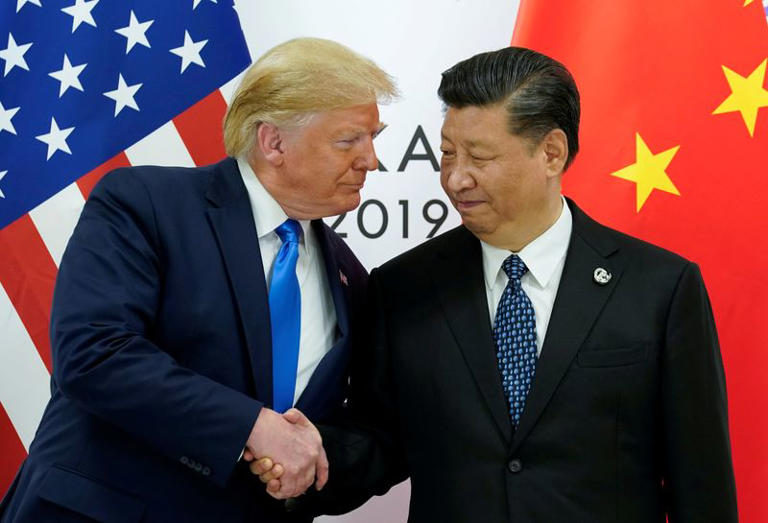China has unveiled a new set of measures aimed at boosting its ailing economy, but these plans could be significantly hindered by the return of Donald Trump to the White House. The country is already grappling with a range of economic challenges, including rising local government debt, sluggish growth, and a property slump. As Trump prepares for a potential second presidency, his promises of steep tariffs on Chinese goods could further strain the world’s two largest economies.
The Chinese government is seeking to address tens of billions of dollars in local government debt, which has become a drag on economic growth. Over the years, local governments borrowed heavily to fund infrastructure projects, but with the downturn in the property market, many cities are now unable to pay off their loans. To combat this, China plans to inject an additional 6 trillion yuan (about $840 billion) into local governments by 2026 to prevent the debt from worsening and to stabilize growth.
However, even as China pushes forward with these measures, it faces significant headwinds, particularly from the US. Trump’s victory in the 2016 election was accompanied by his promise to impose tariffs as high as 60% on Chinese-made goods, and these trade tensions are expected to escalate if he returns to office. During his first term, Trump imposed tariffs of up to 25% on Chinese imports, which took a toll on China’s economy. Despite Trump leaving office in 2021, the Biden administration maintained many of these tariffs, and in some cases, expanded them.
China analyst Bill Bishop notes that Trump’s stance on tariffs should be taken seriously. “I think we should believe that he means it when he talks about tariffs,” he said, referencing Trump’s view that China reneged on a trade deal and that the country’s handling of the COVID-19 pandemic played a role in his 2020 election loss. The prospect of a second Trump presidency could derail China’s plans to become a global technology leader, particularly as the US and other Western nations grow more wary of Chinese exports.
In the wake of the pandemic, China has struggled to return to pre-pandemic growth levels. While other economies quickly bounced back, China’s economic recovery has been slow and fraught with challenges. As of September, the International Monetary Fund (IMF) lowered its growth forecast for China, now expecting the economy to expand by just 4.8% in 2024, down from the country’s original target of around 5%. Next year, growth is expected to slow even further to 4.5%.
Despite these struggles, China is trying to pivot toward a new economic model. In 2017, President Xi Jinping declared that China would move from a focus on “rapid growth” to a “stage of high-quality development.” This strategy is centered on building a more advanced, technology-driven economy that prioritizes sectors like green energy and high-tech manufacturing.
However, some economists warn that China’s heavy reliance on exports may not be sustainable. Stephen Roach, former chairman of Morgan Stanley Asia, argues that China risks entering a period of prolonged stagnation similar to Japan’s economic struggles in the 1990s. Roach suggests that China should tap into domestic consumer demand and shift away from its dependence on export and investment-led growth. Such a shift could help China build a more resilient economy, reduce trade tensions, and lessen vulnerability to external economic shocks, including those caused by Trump’s trade policies.
China is already a leader in certain high-tech industries, such as electric vehicles (EVs), solar panels, and lithium-ion batteries. According to the International Energy Agency (IEA), China accounts for 80% of global solar panel production and is the largest manufacturer of EVs and batteries. In 2023, exports of EVs, batteries, and solar panels from China grew by 30%, surpassing one trillion yuan ($139 billion), helping to offset the negative effects of the country’s ongoing property crisis.
Still, China’s export success has led to increasing resistance from Western countries. For example, the European Union recently raised tariffs on Chinese-made EVs to as much as 45%. This growing protectionism poses a serious challenge to China’s goal of becoming a global leader in high-tech manufacturing. “The problem right now is that large recipients of those goods, including Europe and the US, are increasingly reluctant to receive them,” said Katrina Ell, research director at Moody’s Analytics.
As Trump prepares to take office once again, his commitment to high tariffs and protectionist policies could force China to rethink its economic strategies. While China’s recent economic measures may help stabilize its domestic economy, the impact of rising tariffs and increased resistance from Western markets could undermine these efforts. The next few years will be crucial for China as it navigates the dual challenges of domestic reform and external pressures, particularly from the US.
In conclusion, China’s ambitious plans for economic transformation face significant risks as Trump’s return to power could escalate trade tensions. While the country seeks to transition toward a more advanced, technology-driven economy, the rising resistance to Chinese exports and the possibility of increased tariffs could complicate its path to recovery. Whether China’s new economic measures will be enough to overcome these challenges remains uncertain.









